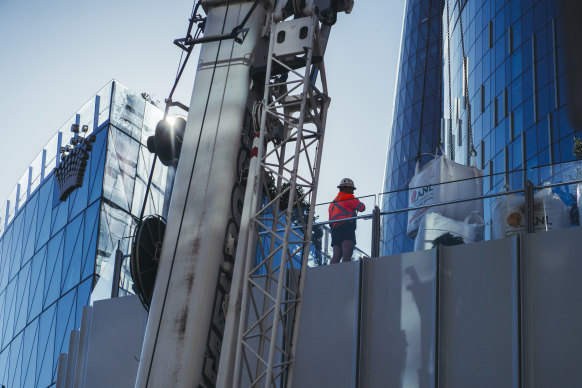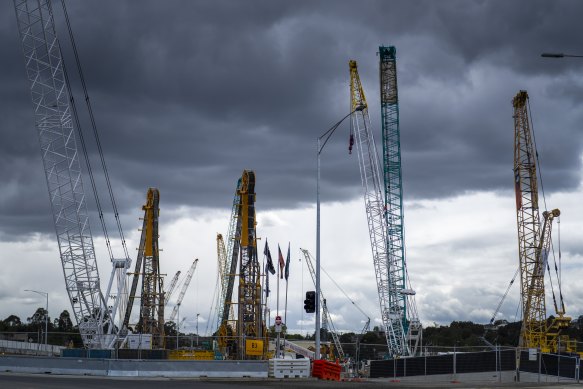More cranes on city skylines, but fewer are building homes
Construction activity is peaking across Sydney’s skyline, where the profusion of cranes outnumbers other Australian capitals, including Melbourne.
The latest RLB Crane Index shows the country’s construction sector remains buoyant with 863 cranes on sites nationally, a figure slightly down on last year, but around the same levels seen in 2022.

Sydney and NSW account for nearly half the country’s cranes on the RLB Index.Credit: Dion Georgopoulos
But the index also shows that while cranes deployed on civil and infrastructure projects are increasing, construction of urgently needed apartments to fix the nation’s housing crisis is decreasing.
The index, compiled by global consultancy Rider Levett Bucknall, provides a twice-yearly snapshot of activity.
Australia is building 15,000 fewer homes than needed each quarter to reach the Albanese government’s target of 1.2 million new homes by 2029, the latest housing data from the Australian Bureau of Statistics (ABS) shows.
New home completions rose 7.3 per cent in the June quarter, but the number of new homes being started has fallen, with apartment and townhouse commencements down 12.3 per cent over the past 12 months.
The Property Council’s group executive for policy and advocacy, Matthew Kandelaars, said Australia needs to build its way out of the housing crisis.
“Although it is encouraging to see an increase in the number of completed homes, [the] figures show how far we have to go if we hope to reach our 1.2 million new homes target,” Kandelaars said.
“That new housing commencements are down is a particularly worrying sign and shows how fragile our housing pipeline is,” he said.
These numbers are well below what’s required to meet the government’s ambitious targets for the next five years, said economist Saul Eslake. “Unless something seemingly miraculous happens, those targets won’t be met.”
“That’s not necessarily the federal government’s fault, because most of the impediments to housing supply are at the state and local government level,” he said.
A squeeze on skilled construction workers – many of whom are choosing to work on the multiple state government infrastructure projects that are under way – is also exacerbating the problem, Eslake said.
RLB’s Oceania director of research and development, Domenic Schiafone, said the volume of commencements, decreasing across all sectors, was now below decade averages.
“We’ve still got plenty of work on now, but those commencements are going to be the work in two years’ time,” he said.
Sydney and NSW are the main activity drivers on the RLB Index, accounting for nearly half the country’s cranes.
“Traditionally, Sydney’s always had more [cranes] than Melbourne,” Schiafone said, adding that Sydney had many more mid-tier (five- to six-level) apartment blocks being built at any one time than Melbourne, where the norm is high-rise.
Melbourne’s residential market has slowed “quite dramatically”, making the gap between the two cities’ crane activity quite significant. Sydney hosts 387 cranes, while Melbourne has 191 fewer.
Currently, 57 per cent of all cranes – a total of 493 – are working on apartments around the country, down from 535 at last count. About 134 were added to residential projects over the six months to September, but a larger number (176) were removed from sites.

Melbourne’s $36 billion North East Link project has the largest crane deployment of any single project in the country.Credit: Eamon Gallagher
“Development costs and feasibility are not stacking up at the moment. It’s difficult for developers to get projects out of the ground,” Schiafone said.
The number of non-residential cranes hit a new peak of 370 over six months to September, rising 10 per cent on the previous half-year in line with ABS data, which showed construction was up 2.2 per cent (or $3.3 billion) in the first six months of this year.
Strong migration into Australia is also contributing to the country’s housing woes. Net overseas migration – the growth or decline in population – over the year to June 2023 was 528,000 people, the highest since records began.
That figure is expected to drop significantly this financial year, but is still likely to grow at around 2 per cent in coming years, according to the ABS and the Centre for Population.
“I wouldn’t dispute for a moment that the surge in immigration has exacerbated our housing problems, but it isn’t the fundamental cause of it,” Eslake said.
The Market Recap newsletter is a wrap of the day’s trading. Get it each weekday afternoon.